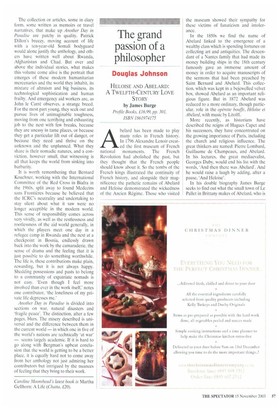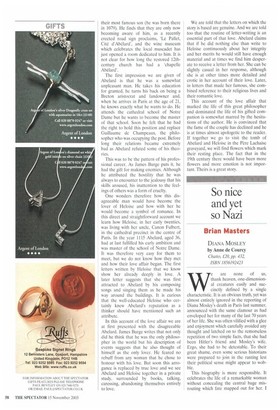The grand passion of a philosopher
Douglas Johnson
HELOISE AND ABELARD: A TWELFTH-CENTURY LOVE STORY by James Burge Profile Books, £16.99, pp. 301, ISBN 1861974175 A. belard has been made to play many roles in French history. In 1796 Alexandre Lenoir created the first museum of French
national monuments. The French Revolution had abolished the past, but they thought that the French people should know about it. So the tombs of the French kings illustrated the continuity of French history, and alongside their magnificence the pathetic remains of Abelard and Heloise demonstrated the wickedness of the Ancien Regime. Those who visited the museum showed their sympathy for these victims of fanaticism and intolerance.
In the 1850s we find the name of Abelard linked to the emergence of a wealthy class which is spending fortunes on collecting art and antiquities. The descendant of a Nantes family that had made its money building ships in the 18th century famously gave an immense amount of money in order to acquire manuscripts of the sermons that had been preached by Saint Bernard and Abelard. This collection, which was kept in a bejewelled velvet box, showed Abelard as an important religious figure. But in 1872 Abelard was reduced to a more ordinary, though particular, role in the operette bouffe, He1W:se et Abelard, with music by Litolff.
More recently, as historians have described the reigns of Hugues Capet and his successors, they have concentrated on the growing importance of Paris, including the church and religious influence. The great thinkers are named: Pierre Lombard, Guillaume de Champeaux, and Abelard. In his lectures, the great mediaevalist, Georges Duby, would end his list with the words, 'And then there was Abelard-. And he would raise a laugh by adding, after a pause, 'And Heloise'.
In his double biography James Burge seeks to find out what the small town of Le Pallet in Brittany makes of Abelard, who is their most famous son (he was born there in 1079). He finds that they are only now becoming aware of him, as a recently erected road sign proclaims, 'Le Pallet, Cite d'Abelard', and the wine museum which celebrates the local muscadet has just opened a room dedicated to him. It is not clear for how long the restored 12thcentury church has had a `chapelle Abelard'.
The first impression we are given of Abelard is that he was a somewhat unpleasant man. He takes his education for granted, he turns his back on being a Breton aristocrat and landowner and, when he arrives in Paris at the age of 21, he knows exactly what he wants to do. He attends the cathedral school of Notre Dame but he wants to become the master of that school. Soon he felt that he had the right to hold this position and replace Guillaume de Champeaux, the philosopher who was occupying the post. Before long their relations became extremely had as Abelard refuted some of his theories.
This was to be the pattern of his professional career. As James Burge puts it, he had the gift for making enemies. Although he attributed the hostility that he was always to encounter to the jealousy that his skills aroused, his inattention to the feelings of others was a form of cruelty.
One wonders therefore how this disagreeable man would have become the lover of Heloise and how with her he would become a symbol of romance. In this direct and straightforward account we learn how Heloise, in her early twenties, was living with her uncle, Canon Fulbert, in the cathedral precinct in the centre of Paris. In the year 1115 Abelard, aged 36, had at last fulfilled his early ambition and was master of the school of Notre Dame. It was therefore very easy for them to meet, but we do not know how they met and how their love affair began. The first letters written by Heloise that we know show her already deeply in love. A later letter suggests that she was first attracted to Abelard by his composing songs and singing them as he made his way around the buildings. It is curious that the well-educated Heloise who certainly knew Abelard's reputation as a thinker should have mentioned such an attribute.
In this account of the love affair we are at first presented with the disagreeable Abelard. James Burge writes that not only did he think that he was the only philosopher in the world but his description of events suggests that he also thought of himself as the only lover. He feared no rebuff from any woman that he chose to honour with his love. But soon this arrogance is replaced by true love and we see Abelard and Heloise together in a private study, surrounded by books, talking, caressing, abandoning themselves entirely to love.
We are told that the letters on which the story is based are genuine. And we are told too that the routine of letter-writing is an essential part of that love. Abelard claims that if he did nothing else than write to Heloise continuously about her integrity and her merits he would still have enough material and at times we find him desperate to receive a letter from her. She can be slightly casual in her response, although she is at other times more detailed and erotic in her account of their love. Later, in letters that made her famous, she combined reference to their religious lives and their romantic love.
This account of the love affair that marked the life of this great philosopher and dominated the life of his gifted companion is somewhat marred by the hesitations of the author. He is convinced that the fame of the couple has declined and he is at times almost apologetic to the reader. If together we go to visit the tomb of Abelard and Heloise in the Pere Lachaise graveyard, we will find flowers which mark their resting place. The fact that in the 19th century there would have been more flowers and more emotion is not important. Theirs is a great story.



























































































 Previous page
Previous page